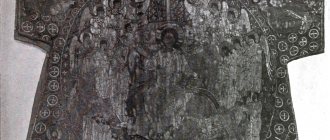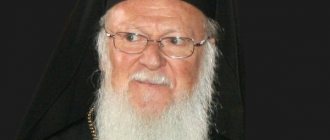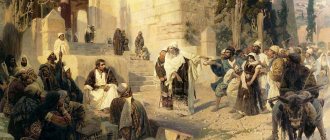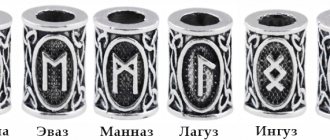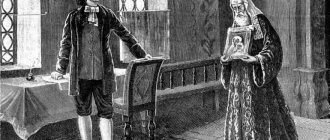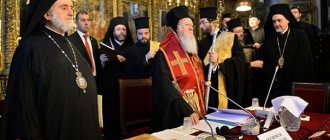Ferraro-Florence Cathedral
1438-1445 - Council of the Western Church, convened by Pope Eugene IV in opposition to the Council of Basel (sometimes seen as a continuation of the Council of Basel). It took place in 1438–1439 in Ferrara, in 1439–1442 in Florence, in 1443–1445 in Rome. Most of the participants in the Basel Council refused to participate in the Florence Council, and the Western European sovereigns invited to it did not come. A large delegation of the Eastern (Orthodox) Christian Church took part (Byzantine Emperor John VIII Palaiologos (1425-1448), Patriarch Joseph II of Constantinople, Russian Metropolitan Isidore, representatives of the Eastern Patriarchs, etc.
The main goal of the Florence Council was to overcome dogmatic differences between the Western and Eastern churches and conclude a union between them. With the help of the union, the Pope hoped to subjugate the Orthodox East to his power. The Byzantine Emperor John VIII Palaiologos was forced to take such an extreme measure as concluding a union with the papal throne in the hope of saving the remnants of the Byzantine Empire from enslavement to the Ottoman Turks with the help of the Pope and Western sovereigns. Both sides agreed to consider the council ecumenical.
At the council, dogmatic disputes broke out about the filioque, the sacraments, purgatory, and the supreme power of the pope; a total of 15 meetings were held in the disputes. Metropolitans Mark of Ephesus and Vissarion of Nicaea especially stood out on the Greek side. Mark of Ephesus did not make any concessions in favor of Latin teaching and called the Latins heretics.
The increasing Turkish danger and papal pressure forced the Byzantines to conclude the Union of Florence (July 1439) on the terms of recognizing the supremacy of the pope, accepting Catholic dogmas while preserving only the rituals of the Eastern Christian Church.
All the Greek bishops present at the council signed the union, except for Mark of Ephesus and Patriarch Joseph II of Constantinople, who had died by that time. The union was also signed by the Russian Metropolitan Greek Isidore (who had long ago agreed to it), for which he was deposed by the Grand Duke of Moscow Vasily II the Dark.
The Union of Florence never came into force either in Byzantium or in the Russian state.
Union of Florence
Reasons for signing the union
The Union of Florence was adopted in 1439
at a council in Basel and Florence in difficult circumstances for the Byzantine Empire.
In 1430
, the Turks captured Thessalonica, and the state practically lost its territory; only the capital remained, which was surrounded by Turkish possessions.
Such a difficult situation led to the fact that Emperor John VIII
Palaiologos was forced to turn to Eugene IV, Pope of Rome, for assistance, hoping to organize a crusade against the Ottoman conquerors. He made a proposal to begin negotiations to unite the Western Catholic and Eastern Orthodox Churches. The pope readily agreed to this proposal. This is explained by the opportunity to fulfill the centuries-old desire to subjugate the Eastern Church; the Byzantine emperor had the opportunity to win the confrontation with the participants in the conciliar movement.
Agreement
IN 1431
In 2010, an ecumenical council was convened in the city of Basel; soon the pope decided to dissolve it, but continue the meetings.
Eugene IV
used his proposal to split the ranks of his opponents. He calls on the assembled representatives of the church to change the venue; most of the cathedral gathered in Ferrara, and later in Florence.
The meetings of the Council of Florence took place in the presence of 700
members of the Byzantine delegation led by the emperor and the monarch of Constantinople, the Metropolitan of Kiev was also present.
Long theological debates took place here, as a result of which June 6, 1439
, a union was signed, uniting the Catholic and Orthodox churches.
By concluding an agreement, the Eastern Church was forced to make serious concessions: the supremacy of the Pope was recognized, some Catholic dogmas were accepted, while Orthodox rituals were preserved.
Over the next 6
years, the cathedral in Florence adopted agreements on merging with other Christian movements. The Union of Florence raised the authority of the pope in Western European countries, but its unviability was revealed. The Catholic Church portrayed this agreement as a crucial act that united Christians and saved Byzantium from the Turkish conquerors. In fact, the union was intended to become an obedient instrument of the pope's policy, which was aimed at subordinating the Catholic Church to the weakened Byzantium and the Russian state. The population of the Byzantine Empire and Rus' became irritated by the union; the majority of the Orthodox clergy did not recognize the document.
How was the union perceived in Rus'?
After Metropolitan Isidore returned from the cathedral, messages about the Council of Florence were sent throughout the Russian lands, and the initiation of believers into Catholic churches began. Many believers were waiting for him in Moscow; the Assumption Cathedral became the meeting place for the patriarch. A Catholic cross was carried in front of Isidore. During the service, the pope was remembered in prayer. After the service, the charter of the Union of Florence was solemnly read.
Metropolitan Isidore, who signed the agreement, was subjected to imprisonment. This was done by order of the Grand Duke of Moscow, Vasily II the Dark. Isidore is the last patriarch, Greek by birth. Subsequently, only Russians headed the church, and the Moscow Patriarchate became independent.
Refusal of the union
The majority of Orthodox bishops, returning to Constantinople, renounced the union; they claimed that they were forced to come to an agreement with the Catholics. Uniates are recognized as heretics.
Mark of Ephesus is the only bishop who refused at the council 1439
sign the union, Orthodox priests united around him.
The patriarchs of Alexandria, Antioch and Jerusalem
convened a council in Jerusalem 1443
The repeated condemnation of the Union of Florence by the Eastern Patriarchs was carried out in 1450
year at the Council of Constantinople. On it, the Uniate, Patriarch of Constantinople Gregory Mamm, was deposed. Athanasius, a supporter of the Orthodox faith, was elected as the new head of the church.
IN 1453
The year the Ottoman Empire captured Constantinople, the Union of Florence was completely forgotten.
The significance of the council's decisions in history
The Union between the Catholic and Orthodox Churches of 1439, an attempt to unite the Christian churches of the East and West, was a complete failure, dividing Christians even more deeply into Orthodox and Catholics. However, in one local area - on the territory of Ukraine and Belarus, then belonging to the Grand Duchy of Lithuania - this agreement determined the development of the Christian church for many years.
For Russia, the main consequence of the union is the acquisition of autocephaly. Guided by the fact that “Tsargrad”, that is, Constantinople, followed the lead of the “Latins”, “schismatics”, “heretics”, Moscow decided to reject the spiritual support of Byzantium, especially since this state soon ceased to exist, and the throne of its Patriarch lost influence. As a result, the Moscow Metropolitan was installed without the blessing of Constantinople, and the Orthodox Church of Rus' was divided into two metropolitanates with centers in Moscow and Kyiv.
If Kyiv remained faithful to the “cradle of Orthodoxy,” even though it was under the heel of the Turks, then Moscow began to publish the works of its theologians year after year, castigating the “Greek defectors” and glorifying the steadfastness and inflexibility in the faith of the Moscow princes.
In the case of the Kyiv Metropolis, everything was more complicated. Until the beginning of the 16th century, the Roman pontiffs took a direct part in its affairs, appointing metropolitans in accordance with the Florentine agreements. In conditions when the Uniate Patriarch of Constantinople lived in Rome, the status of the Kyiv diocese was in limbo.
For several decades, the metropolitans did not recognize the fact that the documents on the basis of which the reconciliation of churches was achieved were no longer valid either in the eyes of Rome or in the eyes of Constantinople, which became Istanbul. And only more than half a century after the Council, which became the beginning of the union, they became convinced that the highest Catholic hierarchs of Poland and the Grand Duchy of Lithuania considered it to have lost all meaning.
Only a century and a half later, the Union of Brest of 1596 revived the spirit and principles of its predecessor, but at a local rather than a church-wide level.
III. Gennady Scholary.
Special mention should be made of George Scholarius, who later became known as Gennady, Patriarch of Constantinople (from 1453). At the Council, he signed the Union Act and did not show any hostility against the Latins, but later he became an aggressive enemy of the Union. However, even in 1451, when the Greeks sent a message to Rome on behalf of the Synaxis of the Church of Constantinople (in fact, about the rupture of the Union), Scholarius (by this time already the monk Gennady), a participant in the Synaxis, refused to put his signature on the official anti-union document ( Runciman
2008, 140). Gennady became an “enemy of the Union” for purely political reasons - having already become patriarch under Sultan Mehmet II. The Sultan fought with the Western Catholic powers and if an Orthodox spoke out in favor of the Catholics, he was executed as a state criminal.
It is important to take into account that Gennady himself was personally a “Thomist”, i.e. consistently embodied the principles of theology into Orthodoxy, as they are presented in the Summa of Thomas Aquinas. It was Gennady who was the first (!) Orthodox theologian who not only praised Aquinas and Scholasticism, but also transferred the Latin doctrine of transsubstance in the Eucharist to the soil of Byzantine theology (since I consider this teaching erroneous, Gennady’s merit is, from my point of view, questionable ).
Events. List - unions, wars, battles, confederations
- 1794 Kosciusz uprising against the partitions of the Polish-Lithuanian Commonwealth
- 1830 November uprising in the wake of the French Revolution of 1830
- 1863 Kalinovsky uprising “Brothers Belarusians, good times have come!”
- 1920 Slutsk zbroyny chyn “Belarusian-Rasei vine”
- 1381-1392 Civil war in the Grand Duchy of Lithuania Vytautas against Jagiello
- 1409-1411 Great War with the Teutonic Order for Samogitia
- 1432-1438 Civil war in the Grand Duchy of Lithuania Western voivodeships against eastern
- 1487-1537 Wars with Muscovy that determined the modern eastern border of Belarus 1487-1494 1500-1503 1507-1508 1512-1522 1534-1537
- 1512-1522 War with Muscovy, loss of Smolensk and the Battle of Orsha
- 1558-1583 Livonian War with Muscovy, aggression of Ivan the Terrible and Union of Lublin
- 1600-1611 War for Estonia Sigismund III Vasa against Sweden
- 1609-1618 Moscow War capture of Moscow by the troops of Sigismund III Vasa
- 1654-1667 “Bloody Flood” 13-year Moscow invasion
- 1696-1702 Civil war in the Grand Duchy of Lithuania, the confederation of the gentry against Sapieha
- 1700-1721 Great Northern War with Sweden
- 1812-1814 Napoleon’s War with Russia “is not a Patriotic War, but a Civil War for Belarus”
- 1919-1930 War of the “Green Oak Party” “Belarusian Silan Party” against Soviet power
- 1914-1918 World War I collapse of four empires
- 1939-1945 World War II largest armed conflict in history
- Unsuccessful attempts...
Uprisings
Wars
- 1385 Union of Krevo dynastic marriage of Jagiello and Jadwiga
- 1401 Union of Vilna-Radom treaty between Vytautas and Jogaila
- 1413 Union of Gorodel and the “Act of Adoption” of the gentry armorial brotherhood
- 1432 Union of Grodno return to the conditions of the Vliena-Radom Union
- 1439 Church Union of Florence unity of Catholics and Orthodox in the world
- 1499 Union of Krakow-Vilna renewal of the Union of Gorodel
- 1501 Union of Melnitsky not approved by the Seimas of the Grand Duchy of Lithuania
- 1569 Union of Lublin creation of the Polish-Lithuanian Commonwealth
- 1573 Warsaw Confederation equality of all religions
- 1573 Henry's Articles oath of elected kings
- 1596 Church Union of Brest - unity of Catholics and Orthodox Christians in the Polish-Lithuanian Commonwealth
- 1655 Union of Keidan, breaking the union with Poland and union with Sweden
- XVIII century Confederation of gentry attempts to preserve the state
- 1791 Constitution of 3 May o
- 1772-1795 Partitions of the Polish-Lithuanian Commonwealth three scars on the heart of the Land
- 1067 Battle of Nemiga Vseslav the Magician against the Yaroslavichs
- 1362 Battle of Blue Waters with the Golden Horde, annexation of the Russian Lands
- 1399 Battle of Vorskla with the Golden Horde
- 1410 Battle of Grunwald with the Teutonic Order, annexation of Samogitia
- 1514 Battle of Orsha Moscow expansion stopped for 200 years
- 1564 Battle of Ula (Battle of Chashniki) with Muscovy, Livonian War
- 1605 Battle of Kirgholm with Sweden, war for Estonia)
- 1610 Battle of Klushino war with Muscovy and capture of the Kremlin
- 1621 Battles of Khotyn with the Ottoman Empire, the last battle of J. Chodkiewicz
- 1649 Battle of Loev with the Zaporozhian Army, Cossack uprisings
- 1660 Battle of Lyakhovichi (siege) with Muscovy, “Bloody Flood”
- 1660 Battle of Polonka with Muscovy, the main battle of the “Bloody Flood”
Unions and confederations
Battles
Church union (lat. union) - a merger of the Orthodox and Catholic confessions, and, on the one hand, the supremacy of the pope, purgatory, the presence of the Holy Spirit and from the Son are recognized, on the other hand, the marriage of white clergy and worship in their native language is allowed, with the preservation of eastern rituals
Encyclopedic Dictionary of Brockhaus and Efron, 1890:
» Union was not an accidental phenomenon; Nor was it the result of personal calculations and willful actions of individual representatives of the Orthodox church hierarchy. It was determined by the historical life of the Russian Orthodox Church in Lithuania and was its direct result.
The main obstacle to the introduction of the Union was that the Western Russian Church was subordinate to the Moscow Metropolitan, and the latter was always a zealous opponent of not only any union, but even rapprochement with the Catholic Church.
Around 1414, people in Lithuania were very dissatisfied with the Moscow Metropolitan Photius. Vytautas, who ruled Lithuania at that time, decided to establish an independent Lithuanian metropolis. In 1415, a council of Western Russian Orthodox bishops was convened in Novogrudok, and the Bulgarian Gregory Tsambalak was elected metropolitan.
After the death of Vytautas, the thought of Union did not disappear in Lithuania. Regarding the union of churches, Metropolitan Gerasim, appointed Western Russian metropolitan in 1433 from among the Smolensk bishops, entered into communication with the pope. When the Union of Florence was concluded in 1439, the Lithuanian government recognized it and the rights of the Catholic clergy were equalized with the rights of the Orthodox.
Under Alexander Jagiellon, a new attempt was made to introduce Union in Lithuania. In 1498, Smolensk Bishop Joseph Bolgarinovich was appointed to the Kyiv metropolitanate, who immediately began to act in favor of the Union with Rome. He turned to Pope Alexander VI with a letter in which he confessed faith according to the Latin model, recognized the Council of Florence and placed himself and his church under the patronage of the pope.
Alexander's successor, Sigismund I, treated Gentiles, Protestants and Orthodox Christians quite peacefully: one of the most influential people under him was the famous defender of Orthodoxy in Lithuanian Rus, Prince Konstantin Ivanovich Ostrozhsky. "
1569 Union of Lublin - creation of the Polish-Lithuanian Commonwealth
1573 Act of the Warsaw Confederation - proclamation of the equality of all religions.
1596 Brest Church Union - adopted to reduce inter-confessional contradictions and reduce the influence of Moscow on the internal affairs of the state - the transition of Orthodox parishes to Greek Catholic (Uniate) ones. As in 1439, there were dissatisfied people. St. died a martyr's death. Josaphat Kuntsevich - “apostle of unity”, Archbishop of Polotsk, preacher of the Union.
I. Sources about the Ferraro-Florence Council and the structure of the latter.
Cathedral of Santa Maria del Fiore, where the Union of Florence was signed.
We have reached four versions of the description of the history of the Cathedral, left by eyewitnesses:
(A) Word of Dorotheus, Metropolitan. Mytilene;
(B) A lengthy description of the history of the cathedral by Sylvester Siropul. In 1437 he became the great ecclesiarch of the Church of Constantinople and in this rank he participated in the work of the Ferrara-Florence Council;
(C) Works of Mark Eugenicus, Metropolitan of Ephesus;
(D) Description of the history of the cathedral by Horatio Giustiniani - from the side of the Roman Church.
But since Dorotheus (A), although a Greek, was an active Uniate, and Horatio (D) was himself a clergyman of the Roman Church and, of course, looked at the cathedral “through the eyes of the Latins,” then we only have the testimony of Mark of Ephesus (C) and a voluminous work, actually “history” in the true sense of the word, the author of which is Sylvester Syropulus (B), who later was one of the patriarchs of Constantinople (with the name Sophronius I) during the Ottoman period.
Below we will focus on Sylvester's recollection, since he is, firstly, a good chronicler, and secondly, not a supporter of the Union. The memories of this Council participant are of global significance. It shows the inconsistency of not only the Latin position, but also the Greek one. How hesitantly the Greeks began to debate theological issues. In the dispute about the “Creed,” they took a deliberately losing position, and the Latins were right on this issue both from the theological and historical sides. By the way, it was Siropul who made it possible to draw attention to some contradictory character traits of Mark of Ephesus.
The pillars of Latin theology represented at this Council: Julian [Julian] Caesarini, Nicolaus Albergati, the Spanish theologian Juan de Torquemada, the famous theologian Fra John of Ragusa.
At the very beginning of the Council of Ferrara, Julian Cesarini pointed out four main differences: Filioque - Unleavened Bread - Purgatory - Papacy ( Syropul
5:15, and, as we will see further from the introductory words of Mark of Ephesus, he did not initially consider the phenomenon of papacy itself a problem). The cathedral moved in this direction. Moreover, from the order of the Greeks’ answers it is clear that the latter considered questions about Filioque and Unleavened Bread more significant than questions about purgatory and the power of the pope. The Greeks already considered the first two questions resolved, and the second two - “controversial and not directly related to the dogmas of faith.” But also at the council “in parallel” they touched upon the issues of Uncreated Energies and the Epicleses.
On none of the questions during the interviews did the Greeks come to results expressed in convincing evidence. Those. the Greeks simply “insisted on patristic antiquity,” ignoring the possibility of theological development of the issue.
The Latins immediately noticed that the Greeks, “taking up a topic and entering into a debate, abandoned the conclusion and entered into a dispute on the next issue” ( Siropoul
, 7:23).
At the same time, the Greeks imagined themselves to be “the persuading and accusing party” ( Siropul
, 8:1).
And even Syropul, who is opposed to the Latins, admits that “ours were entirely in the power of self-exaltation and boasting” ( Siropul
, 10: 28).
The Greeks felt their poverty (both in the field of education and in the art of polemics). Therefore, they constantly sabotaged the dialogues, which the Latins quite rightly blamed them for ( Siropul
8:24-25).
Siropul himself expressed an important point about the need for a scientific-critical study of the sources of the opposite side, but he himself admitted that the Greeks did not have any opportunity to study the sources and give a positive or negative assessment of the Latin sources regarding their authenticity ( Siropul
9:7).
But the Latins also “went too far” due to a similar ignorance regarding the Greek tradition. Thus, the Latins demanded that the Greeks abandon the epiclesis in the Eucharist, considering it a “late insertion” into patristic texts ( Siropoul
10: 2-3).
The Ferraro-Florence Council was indeed different - in procedure
– from other Ecumenical Councils of antiquity.
The latter had not only a lively discussion, but also its own “general line”. However, the quantity there did not matter. Yes, they could “silence” the voice of a convincing opponent, but the “victory” over the opponent was presented as the result of a discussion, and not the result of “convincing the majority.” In Florence, the emperor began to dictate a line of behavior to the Greeks, imposing certain results under the guise of “majority consent” ( Syropulus
8:11).
Ecumenical Councils were first convened in the empire by the emperor, and the popes were not even present in person. But in Florence, the Byzantines were faced with a phenomenon unknown to them: Now, it turns out, the Church itself convenes Councils and even without the knowledge of the emperor ( Siropoul
10:4).
